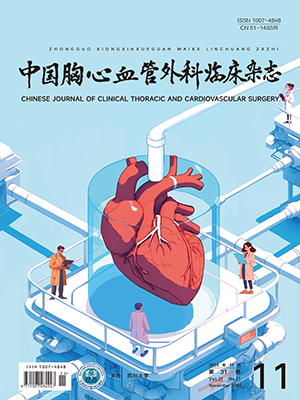| 1. |
Wolfe GI, Kaminski HJ, Aban IB, et al. Randomized trial of thymectomy in myasthenia gravis. N Engl J Med, 2016, 375(6): 511-522.
|
| 2. |
Gilhus NE, Tzartos S, Evoli A, et al. Myasthenia gravis. Nat Rev Dis Primers, 2019, 5(1): 30.
|
| 3. |
Gilhus NE. Myasthenia gravis. N Engl J Med, 2016, 375(26): 2570-2581.
|
| 4. |
Burt BM, Yao X, Shrager J, et al. Determinants of complete resection of thymoma by minimally invasive and open thymectomy: Analysis of an international registry. J Thorac Oncol, 2017, 12(1): 129-136.
|
| 5. |
Batirel HF. Minimally invasive techniques in thymic surgery: A worldwide perspective. J Vis Surg, 2018, 4: 7.
|
| 6. |
Zieliński M, Kuzdzał J, Szlubowski A, et al. Transcervical-subxiphoid-videothoracoscopic "maximal" thymectomy: Operative technique and early results. Ann Thorac Surg, 2004, 78(2): 404-409.
|
| 7. |
Cooper JD, Al-Jilaihawa AN, Pearson FG, et al. An improved technique to facilitate transcervical thymectomy for myasthenia gravis. Ann Thorac Surg, 1988, 45(3): 242-247.
|
| 8. |
Marulli G, Rea F, Melfi F, et al. Robot-aided thoracoscopic thymectomy for early-stage thymoma: A multicenter European study. J Thorac Cardiovasc Surg, 2012, 144(5): 1125-1130.
|
| 9. |
Marx A, Chan JK, Coindre JM, et al. The 2015 World Health Organization classification of tumors of the thymus: continuity and changes. J Thorac Oncol, 2015, 10(10): 1383-1395.
|
| 10. |
Detterbeck FC, Nicholson AG, Kondo K, et al. The Masaoka-Koga stage classification for thymic malignancies: Clarification and definition of terms. J Thorac Oncol, 2011, 6(7 Suppl 3): S1710-S1716.
|
| 11. |
Verschuuren JJ, Palace J, Murai H, et al. Advances and ongoing research in the treatment of autoimmune neuromuscular junction disorders. Lancet Neurol, 2022, 21(2): 189-202.
|
| 12. |
Punga AR, Maddison P, Heckmann JM, et al. Epidemiology, diagnostics, and biomarkers of autoimmune neuromuscular junction disorders. Lancet Neurol, 2022, 21(2): 176-188.
|
| 13. |
Narayanaswami P, Sanders DB, Wolfe G, et al. International consensus guidance for management of myasthenia gravis: 2020 update. Neurology, 2021, 96(3): 114-122.
|
| 14. |
Wilshire CL, Blitz SL, Fuller CC, et al. Minimally invasive thymectomy for myasthenia gravis favours left-sided approach and low severity class. Eur J Cardiothorac Surg, 2021, 60(4): 898-905.
|
| 15. |
Jiang L, Chen H, Hou Z, et al. Subxiphoid versus unilateral video-assisted thoracoscopic surgery thymectomy for thymomas: A propensity score matching analysis. Ann Thorac Surg, 2022, 113(5): 1656-1662.
|
| 16. |
Cao P, Hu S, Qu W, et al. Subxiphoid-subcostal thoracoscopic thymectomy for seropositive myasthenia offers equivalent remission rates and potentially faster recovery. Interact Cardiovasc Thorac Surg, 2022, 34(4): 576-583.
|
| 17. |
Suda T, Hachimaru A, Tochii D, et al. Video-assisted thoracoscopic thymectomy versus subxiphoid single-port thymectomy: Initial results. Eur J Cardiothorac Surg, 2016, 49 Suppl 1: i54-i58.
|
| 18. |
Qiu Z, Chen L, Lin Q, et al. Perioperative outcomes and mid-term effects in performing video-assisted thoracoscopic extended thymectomy for myasthenia gravis: Subxiphoid versus right thoracic approaches. J Thorac Dis, 2020, 12(4): 1529-1539.
|
| 19. |
Kaufman AJ, Palatt J, Sivak M, et al. Thymectomy for myasthenia gravis: Complete stable remission and associated prognostic factors in over 1000 cases. Semin Thorac Cardiovasc Surg, 2016, 28(2): 561-568.
|
| 20. |
Tian W, Li X, Tong H, et al. Surgical effect and prognostic factors of myasthenia gravis with thymomas. Thorac Cancer, 2020, 11(5): 1288-1296.
|
| 21. |
Liu Z, Yang J, Lin L, et al. Unilateral video-assisted thoracoscopic extended thymectomy offers long-term outcomes equivalent to that of the bilateral approach in the treatment of non-thymomatous myasthenia gravis. Interact Cardiovasc Thorac Surg, 2015, 21(5): 610-615.
|
| 22. |
Xie X, Gan X, Chen B, et al. Left- and right-sided video-assisted thoracoscopic thymectomy exhibit similar effects on myasthenia gravis. J Thorac Dis, 2016, 8(1): 124-132.
|
| 23. |
Álvarez-Velasco R, Gutiérrez-Gutiérrez G, Trujillo JC, et al. Clinical characteristics and outcomes of thymoma-associated myasthenia gravis. Eur J Neurol, 2021, 28(6): 2083-2091.
|
| 24. |
Kim H, Lim YM, Lee EJ, et al. Factors predicting remission in thymectomized patients with acetylcholine receptor antibody-positive myasthenia gravis. Muscle Nerve, 2018, 58(6): 796-800.
|
| 25. |
de Perrot M, Liu J, Bril V, et al. Prognostic significance of thymomas in patients with myasthenia gravis. Ann Thorac Surg, 2002, 74(5): 1658-1662.
|
| 26. |
Liu CW, Luo M, Mei JD, et al. Perioperative and long-term outcome of thymectomy for myasthenia gravis: Comparison of surgical approaches and prognostic analysis. Chin Med J, 2013, 126(1): 34-40.
|




